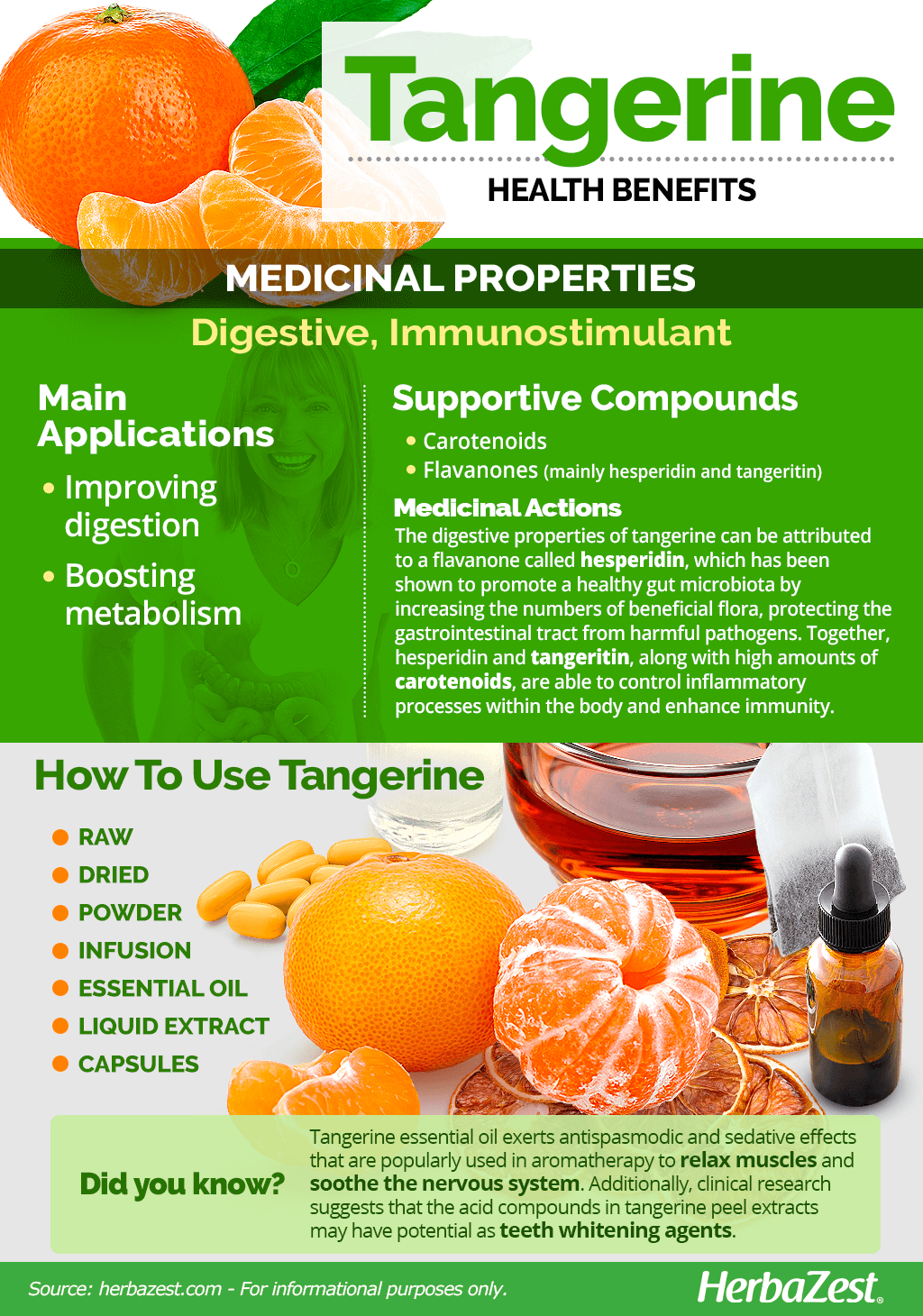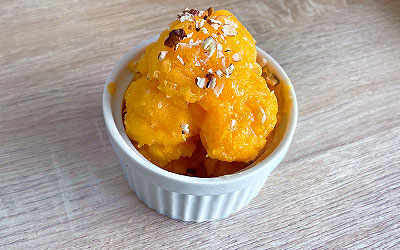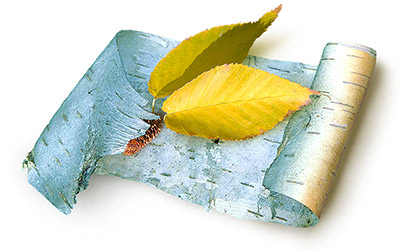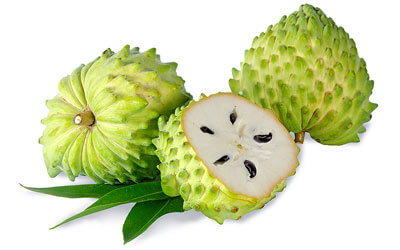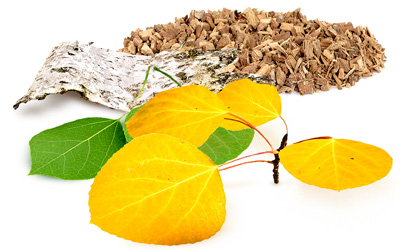Tangerines and mandarins are thought to have originated in Southeast Asia, from where they spread to the Mediterranean region and, eventually, to the rest of the world. Small and easy to peel, tangerine fruits are naturally divided into bite-size sections, ready to consume. The names "tangerine" and "mandarin" are often used interchangeably; however, some botanical classification systems list tangerines as a subgroup of mandarins, and others as a separate species.
Tangerine Medicinal Properties
- Medicinal action Digestive, Immunostimulant
- Key constituents Carotenoids and flavanones (mainly hesperidin and tangeritin)
- Ways to use Capsules, Hot infusions/tisanes, Liquid extracts, Food, Powder, Essential oil, Dried
- Medicinal rating (2) Minorly useful plant
- Safety ranking Safe
Health Benefits of Tangerine
Tangerine benefits are numerous and similar to those of oranges. The peel and flesh of tangerine fruits have been traditionally used to alleviate a wide variety of health conditions; however, tangerine properties are nowadays popularly used for:
Improving digestion. Tangerine promotes the secretion of gastric acids for proper digestion as well as balancing the amount of acids and bile, thus helping alleviate stomach complains, including infections and inflammations.
Boosting metabolism. The antioxidant properties of tangerine promote proper bodily function and optimal absorption of nutrients as well as aid elimination of toxic substances and purification of the blood, thus preventing the attack of potentially harmful pathogens.
Other tangerine properties include antimicrobial, antispasmodic, and sedative actions, mostly concentrated in tangerine's essential oil, which is commonly used for sanitizing superficial wounds, healing fungal skin infections, reducing anxiety and stress, and relieving muscle spasms, both respiratory and digestive.
How It Works
Tangerine health benefits are related to its high levels of antioxidant compounds, mainly carotenoids and flavanones (hesperidin, naringin, tangeritin, and rutin), with strong bioactive properties.
The digestive properties of tangerine can be attributed to hesperidin, a flavanone abundant in this and other citrus fruits. It has been shown effective for improving the composition of gut microbiota by increasing the numbers of beneficial flora, mainly Lactobacillus and Immunoglobulin A (IgA), which is an antibody present in the mucosal secretions of the digestive and respiratory tracts. Higher amounts of IgA and a healthy gut flora have proven to protect against pathogens that can affect gastrointestinal health.1,2,3
Different studies have suggested that hesperidin might be potentially useful for preventing neurodegenerative diseases by reducing neuro-inflammation.4 This important flavanone in tangerine also have shown antioxidant, antidepressant, anti-asthmatic, and immunomodulatory properties.5 Additionally, preliminary studies have suggested the efficacy of tangeritin for improving cognitive impairments, such as the one caused by Parkinson's disease.6
THE PRESENCE OF DIETARY FIBER IN TANGERINE FRUITS CONTRIBUTE TO ENHANCING DIGESTIVE FUNCTION.
On the other hand, tangerine contains carotenoids, a pro-vitamin A group of compounds, which are responsible for the intense yellow-orange pigmentation of citrus fruits. They also encompass strong antioxidants, such as lutein, zeaxanthin, beta-cryptoxanthin, and beta-carotene, all of which have shown to have anti-inflammatory and immunoprotective properties.7
Tangerine essential oil have shown antimicrobial effects against common strains, such as Escherichia coli, Bacillus subtilis, Pseudomonas aeruginosa, and Staphylococcus aureus.8 Moreover, the antispasmodic and sedative effects of tangerine and other citrus essential oils are commonly used in aromatherapy to relax muscles and soothe the nervous system, thus reducing stress and anxiety as well as asthma and muscle cramps.
Other herbs with digestive properties are flax seeds, sweet potato, and yacon, whereas immunostimulant properties can also be found in other foods rich in carotenes and vitamin C, such as bell pepper, camu camu, and lemon.
Tangerine Side Effects
The tangerine fruit is considered safe to consume raw as part of a balanced diet; however, topical use of tangerine essential oil can cause skin rash in sensitive individuals.
Tangerine Cautions
The overconsumption of tangerine may increase the risk of intestinal obstruction in people with gastrointestinal disorders. This citrus fruit should be consumed cautiously by those undergoing cancer treatments as well as by patients taking medicines that are metabolized in the liver.

Tangerine Nutrition
The value of tangerine fruit's nutrition lies in its excellent amounts of vitamin C (ascorbic acid), necessary for the adequate absorption of minerals like calcium and iron as well as strong immunity. The antioxidant power of this water soluble vitamin not only prevents cellular damage, warding off harmful pathogens and degenerative diseases, but also plays a role in collagen production, which promotes skin elasticity, avoiding premature wrinkles.
On the other hand, tangerine fruits provide most vitamins of the B-complex group, particularly good amounts of B1 (thiamin) and B6 (pyridoxine), both of which help transform food into fuel, which the body uses to produce energy. They also help the body metabolize fats and protein and promote optimal brain function. B1 is sometimes called an "anti-stress" vitamin because it helps strengthen the immune system and improves the body's ability to withstand stressful conditions.
Tangerine also contains good amounts of potassium, important for electrolyte balance and blood pressure control, and copper, which plays an important role in blood cell production and blood transport throughout the body, also promoting healthy bones, nerves, blood vessels, and immunity.
Tangerine nutritional value is rounded by the presence of calcium, folate, vitamin A (from carotenes), and smaller amounts of other vitamins and minerals.
100 GRAMS OF RAW TANGERINE (ABOUT 12 SECTIONS) PROVIDE 53 CALORIES AS WELL AS 7 AND 4% OF THE RECOMMENDED DAILY VALUE FOR DIETARY FIBER AND CARBOHYDRATES, RESPECTIVELY.
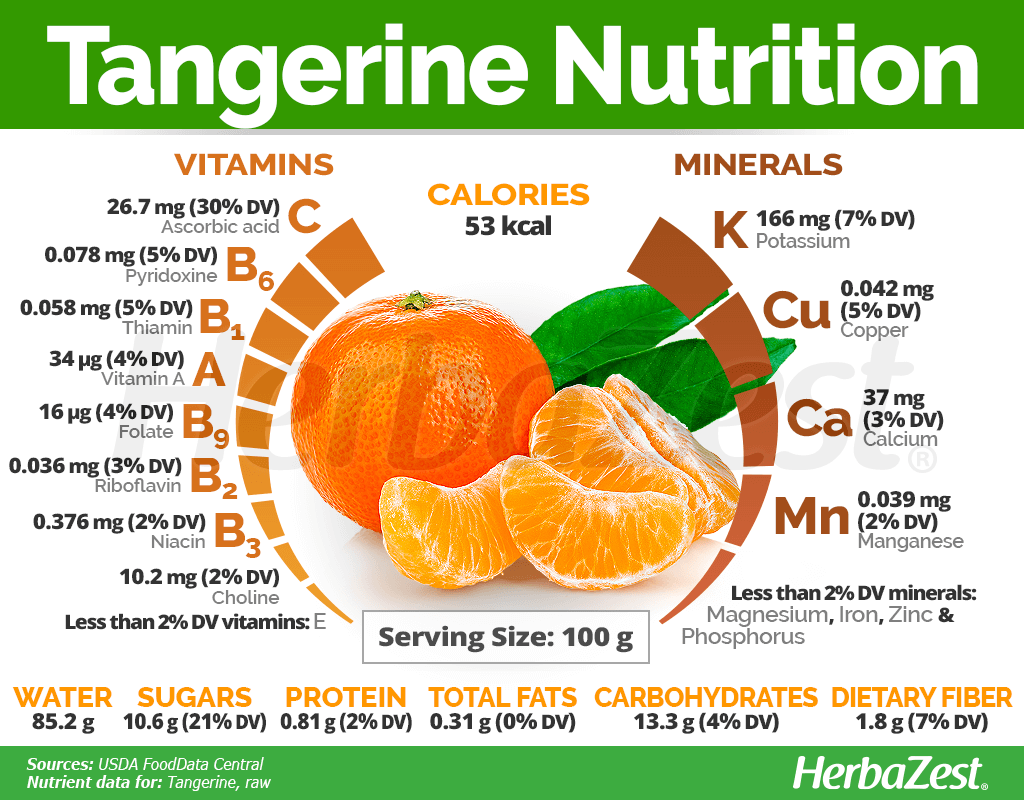
How to Consume Tangerine
- Edible parts Fruit
- Edible uses Flavoring, Beverage
- Taste Sweet
All parts of the tangerine fruit have been a traditional source of both nutrition and medicinal properties. Its nutritional value is mostly reaped from natural forms, whereas tangerine's health benefits can be obtained from medicinal preparations.
Natural Forms
Raw. In its fresh form, tangerine is a healthy, low-carb snack, which can be eaten alone or added to fruit salads and other culinary preparations.
Dried. Once dried, tangerine peels can be added to preserves and medicinal preparations in order to extract their medicinal properties. Tangerine wedges or sections can also be found in dried form and consumed as a healthy snack.
Powder. The dried peels of tangerine are ground into a fine powder that is often used as natural exfoliating agent.
Infusion. Dried tangerine peels can be brewed into a warm tisane to take advantage of their anti-inflammatory, digestive, and mildly sedative properties.
Herbal Remedies & Supplements
Essential oil. Tangerine essential oil not only has antiseptic properties when applied topically, but can also be taken orally to ease digestion, boost immunity, and soothe stress and anxiety.
Liquid extract. Tangerine extract is believed to promote healthy cholesterol, blood sugar levels, and digestion.
Capsules. Tangerine capsules and tablets are a good source of vitamin C and promote a healthy immune system as well as smooth digestion and proper skin health.
A PRELIMINARY STUDY SUGGESTS THAT THE ACID COMPOUNDS IN TANGERINE PEEL EXTRACTS MAY HAVE POTENTIAL AS TEETH WHITENING AGENTS.9

Growing
- Life cycle Perennial
- Harvested parts Fruit
- Light requirements Full sun
- Soil Loamy sand, Well-drained
- Soil pH 6.6 – 7.3 (Neutral)
- Growing habitat Temperate climates
- USDA Plant Hardiness Zones 9b, 10a, 10b, 11a, 11b
- Planting time Early spring
- Plant spacing average 5 m (16.4 ft)
- Propagation techniques Budding, Grafting
- Potential insect pests Aphids, Moths
- Potential diseases Phytophthora spp.
The mandarin or tangerine tree is a subtropical species that grows best in regions with well-defined seasons. In order to cultivate a tangerine plant in a home garden or backyard, some considerations, such as range of temperatures, sunlight exposure, and soil requirements, should be considered.
Growing guidelines
The tangerine tree grows best at temperatures between 55-100°F (12.8 and 37.8°C) during the growing season and 35-50°F (1.7 to 10°C) during dormancy.
While mature mandarin or tangerine trees are hardy to short periods of freezing, young seedlings will be killed. The tangerine fruit cannot withstand freezing conditions.
Tangerine is tolerant to drought conditions, but not to water-logged soil.
Tangerine trees will grow best in a well-drained, sandy loam soil, with a pH between 6.0 and 7.5. Soil must be deep enough to allow adequate root development.
Mandarin or tangerine trees require full sun and should be protected from wind.
Most commonly, the method used to propagate tangerine is grafting or budding to an appropriate rootstock. Tangerine can also be grown from seeds, but it will not produce fruit true to type. Those who want to grow tangerine locally can purchase seedlings already grafted, ready to be planted in a garden or orchard.
Tangerines are best planted in early spring, after the last frost. Standard sized trees should be spaced 12-25 feet (3.7-7.6 m) apart in a sunny area, protected from strong winds. Planting against a south facing wall will help protect the tree in cooler climates.
Young tangerine trees require proper irrigation until they become established. During the first year, water should be applied at the base of the trunk every 3-7 days, in order to provide adequate moisture to the roots and encourage optimal growth. The soil should be moist, but not wet. Trees planted in sandy soils will require water more frequently. A light application of fertilizer is advisable every month during the first year.
The tangerine tree is susceptible to fungal, bacterial and viral diseases, such as anthracnose, black root rot, citrus canker, citrus greener, and citrus tristeza virus.
Additional Information
- Other uses Alcohol, Perfume
Plant Biology
The mandarin or tangerine is a perennial that can be grown as tall as a tree, up to 25 feet (7.5 m), or a small bush, depending on the variety. The tangerine tree is usually thorny, with slender twigs, and glossy, lanceolate leaves. Unassuming but fragrant, tangerine white flowers grow from the leaf axils, individually or in small groups.
The tangerine fruit, also known as Chinese orange, is oval shaped, varies in size from small to large, and has a bright orange or red-orange peel when ripe, with interior sections easy to separate. The seeds are small and tear shaped, and their number varies across the different types of tangerines.
Classification
Tangerin (Citrus reticulata), also known as mandarin, belongs to the Rutaceae family, which comprises over 900 species across 150 genera, including other economically important citrus fruits, such as orange (Citrus sinensis), lemon (Citrus limon), lime (Citrus aurantiifolia), and grapefruit (Citrus paradisi).
Varieties and Cultivars of Tangerine
All tangerine or mandarin fruits have been classified across 36 species, which include a large variety of hybrids and cultivars. This complex taxonomy has been broadly compressed in three large classifications:
Mandarin
Changsa: Bright orange-red hue; sweet, but insipid and seedy; grown as an ornamental
Le-dar: Derived from an Australian mandarin tree; produces brightly colored, large fruits of high quality
Emperor: A popular cultivar native to Australia; large with pale-orange peel and pulp
Oneco: Closely related to 'Emperor' and originally from northwestern India; pear-shaped, medium to large with orange-yellow, glossy, rough peel; rich and sweet orange-yellow pulp
Willow-leaf: Also known as 'China Mandarin;' oval to rounded shape, medium size; smooth, glossy and thin, orange peel and pulp; juicy and sweet; grown mainly as an ornamental and for breeding
Tangerine
Clementine (also known as 'Algerian Tangerine): Oval to round shaped, medium size, smooth, glossy, thick with deep orange-red peel and pulp; juicy and flavorful; 'Clementine' was crossed with 'Orlando' tangelo to produce 'Robinson,' 'Osceola,' and 'Lee' tangerine hybrids
Cleopatra: Also known as 'Ponki', or 'Spice;' oval and small with a dark orange-red peel and pulp; tasty but seedy; of little commercial value; grown mainly as an ornamental
Dancy: Thought to be native to China; oval to pear-shaped, medium size with a deep orange-red to red peel and dark-orange pulp; flavor-rich, with 6 to 20 small seeds; the most commercialized tangerine in the United States, mainly grown in Florida
Ponkan: Also known as 'Chinese Honey Orange;' round to oval shaped, large, with orange and smooth peel and salmon-orange pulp; aromatic, juicy and sweet, with few seeds; popularly grown as a dwarf bush in China, where it is highly valued as a commercial cultivar
Robinson: This cultivar is the result of pollinating 'Clementine' with 'Orlando' tangelo in order to obtain more sections and seeds
Sunburst: Created from hybrids of 'Robinson' and 'Osceola;' oval shaped and medium-sized, with orange to scarlet peel; divided in 11-15 juicy and brightly colored segments
Satsuma (also commercialized as "Emerald Tangerine"). It is believed to have originated in Japan about 350 years ago, and it is highly cold-resistant, surviving temperatures as low as 12º F (-11.11º C) as well as being hardier than the sweet orange to diseases.
Owari: Oval to round and pear-shaped when ripe; medium size with green-orange, slightly rough peel, even when mature; orange pulp with rich, slightly tangy flavor and almost seedless
Wase: Native to Japan and believed to be derived from 'Owari,' large, oval to rounded and slightly conical; thin, smooth, orange-colored peel; sweet, salmon-orange pulp
Kara: An hybrid of 'Owari' and 'King' tangor, developed in California; nearly round, medium sized, with deep-orange to orange-yellow peel; lumpy and wrinkled, with deep yellow-orange pulp, tender, juicy, aromatic, flavorful, and sweet when ripe
Historical information
The tangerine, or orange mandarin, is thought to have originated in Southeast Asia, probably in China, from where it was introduced to India through commercial routes. Later they spread to Japan, where Satsuma mandarins developed about three hundred years ago. Although other citrus species have been grown in Europe and the Mediterranean since Greek and Roman times, Tangerine fruits arrived in Europe much later.
The original 'Clementine' mandarin was selected in Oran, Algeria, in the early 20th century by a French missionary, Father Clement Rodier. Although some sources have described it as an accidental hybrid of sour (Seville) orange and Mediterranean mandarin, it is now thought to be identical to the Canton mandarin of China.
Economic Data
Main tangerine producers are China, Spain, and Japan, followed by Brazil, Italy, Egypt, United States, Morocco, Argentina, Turkey, and Pakistan. Most of global tangerine production goes to the fresh market. Spain has had significant success with its seedless clementine varieties in Europe and, more recently, the United States.
In 2010, world tangerine production was about 18.7 million tons, China being the largest contributor. In 2012, China produced over 13 million tons of different types of tangerine and mandarin, followed by Spain with almost 2 million, and Brazil with nearly 1 million.
Other Uses
Food industry. Tangerine essential oil is employed commercially in flavoring hard candy, gelatins, ice cream, chewing gum, and bakery goods.
Perfume industry. Tangerine essence is highly valued in perfume-manufacturing, particularly in the formulation of floral compounds and colognes.
Beverages. Mandarin essential oil paste is a standard flavoring for carbonated beverages and liquors.
Sources
- Citrus Genetics, Breeding and Biotechnology, p.26
- Dictionary of Flavors, p.404
- Fruits of Warm Climates, Mandarin oranges
- Journal of Food Composition and Analysis, Flavanones in oranges, tangerines (mandarins), tangors, and tangelos: a compilation and review of the data from the analytical literature, 2006
- Molecules, The Chemical Compositions, and Antibacterial and Antioxidant Activities of Four Types of Citrus Essential Oils, 2021
- Natural Product Research, Phytochemical investigation of the fruit peels of Citrus reticulata Blanco, 2010
- Texas A&M Agrilife Extension, Home fruit production - tangerines
- Tropical and Subtropical Fruits: Postharvest Physiology, Processing and Packaging, p. 429–433
- University of Arizona, Mandarins
- USDA Plants Database, Agriculture Handbook Number 66: Mandarin (Tangerine)
- FAOSTAT, Citrus fruits production statistics
Footnotes:
- Phytomedicine. (2009). Modulating effect of Hesperidin on experimental murine colitis induced by dextran sulfate sodium. Retrieved October 20, 2021, from: https://www.sciencedirect.com/science/article/abs/pii/S0944711309000567
- Journal of Functional Foods. (2013). Dietary polyphenols modulate intestinal barrier defects and inflammation in a murine model of colitis. Retrieved October 20, 2021, from: https://www.sciencedirect.com/science/article/abs/pii/S1756464613000662
- Nutrients. (2019). Hesperidin Effects on Gut Microbiota and Gut-Associated Lymphoid Tissue in Healthy Rats. Retrieved October 20, 2021, from: https://www.ncbi.nlm.nih.gov/pmc/articles/PMC6412496/
- Nutritional Neuroscience. (2017). Hesperidin ameliorates cognitive dysfunction, oxidative stress and apoptosis against aluminium chloride induced rat model of Alzheimer's disease. Retrieved October 20, 2021, from: https://www.tandfonline.com/doi/abs/10.1080/1028415X.2016.1144846
- European Journal of Pharmacology. (2016). Hesperidin reverses cognitive and depressive disturbances induced by olfactory bulbectomy in mice by modulating hippocampal neurotrophins and cytokine levels and acetylcholinesterase activity. Retrieved October 20, 2021, from: https://www.sciencedirect.com/science/article/pii/S0014299916304800
- Neuroscience Letters. (2019). Role of tangeritin against cognitive impairments in transgenic Drosophila model of Parkinson's disease. Retrieved October 20, 2021, from: https://www.sciencedirect.com/science/article/abs/pii/S0304394019302903
- Pharmacognosy Research. (2016). Evaluation of Skin Anti-aging Potential of Citrus reticulata Blanco Peel. Retrieved October 20, 2021, from: https://www.ncbi.nlm.nih.gov/pmc/articles/PMC4908842/
- A Journal of Biosciences: Zeitschrift für Naturforschung C (ZNC). (2020). Chemical composition, antioxidant and antimicrobial activity of essential oils from tangerine (Citrus reticulata L.), grapefruit (Citrus paradisi L.), lemon (Citrus lemon L.) and cinnamon (Cinnamomum zeylanicum Blume). Retrieved October 20, 2021, from: https://www.degruyter.com/document/doi/10.1515/znc-2020-0126/html
- Journal of Physics: Conference Series. (2017). Citric acid compounds of tangerines peel extract (Citrus reticulata) as potential materials teeth whitening. Retrieved October 20, 2021, from: https://iopscience.iop.org/article/10.1088/1742-6596/824/1/012071
